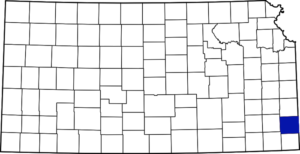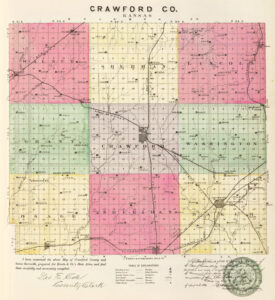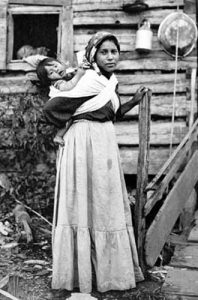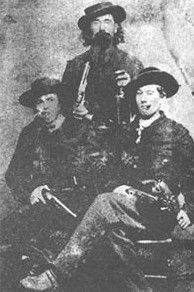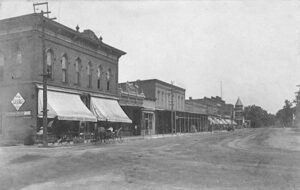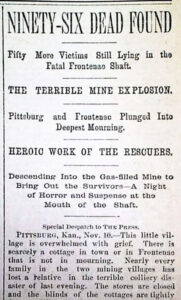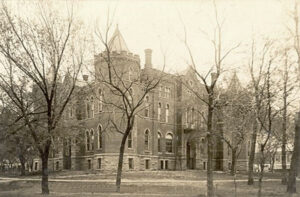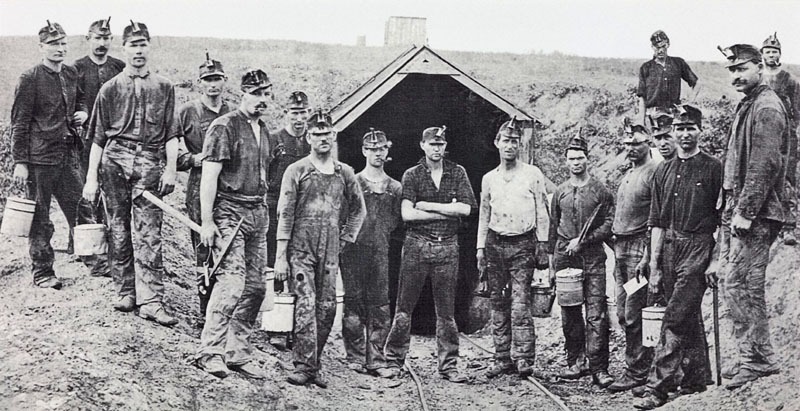
Crawford State Park, Farlington, Kansas, courtesy Crawford County.
Towns:
Arcadia
Arma
Cherokee
Farlington
Franklin
Frontenac
Girard – County Seat
Hepler
McCune
Mulberry
Olopolis
Pittsburgh
Radley
Walnut
Extinct Towns of Crawford County
Crawford State Park
Pittsburg State University
Crawford County, Kansas, located in the southeast portion of the state, is situated in the Osage Cuestas and Cherokee Lowlands. The county was formed from Bourbon and Cherokee Counties in 1867 and named for Samuel J. Crawford, who was the governor at the time.
The area of the county is 595 square miles. The general surface of the county is undulating, with watercourses flowing in three different directions. In the northeast, Drywood, Bone, and Coxes Creeks flow northward to the Marmaton River; in the west, Big Walnut, Little Walnut, and Hickory Creeks flow southwest to the Neosho River; and in the southeast, Lightning, Lime, and Cow Creeks flow southward, before reaching the Neosho River.
Crawford County lies in a tract once known as the “Neutral Lands,” which were ceded by the Cherokee Nation to the United States by a treaty signed on July 19, 1866. Before that time, some attempts were made by white men to settle within the territory. John Leman, a blacksmith, settled in Osage Township in 1848. Harden Mathews settled in Sherman township in 1850. In 1851 P. M. Smith was in Baker Township but did not erect a dwelling, being content to live during his short stay in a tent. As early as 1852, several white men settled in Lincoln Township, including Howard, Fowler, Hale, and the Hathaways. James Hathaway established a blacksmith shop where Arcadia now stands.
A man named Sears built the first house consisting of a log cabin in Osage Township in 1856. Coal was discovered in this township by a government exploring party under Colonel Cowan and was first mined by parties from Missouri in 1857. There were a few white men in Walnut Township the same year. The first school in the county was opened in Lincoln Township in 1858 in a small log house that had formerly been used as a dwelling, the settlers contributing the funds to pay the teacher.
In 1861 the Cherokee Indian agent, acting under orders from President James Buchanan, took a group of United States troops and expelled the settlers, burning their houses and destroying their crops. Others soon came to take the places of those driven out. That same year a man named Banks settled on the Big Cow Creek in Crawford Township.
During the Civil War, the few settlers of the county were seriously harassed by guerrillas and bushwhackers, most of the outrages being committed by the notorious Livingston Rangers. Among those killed by guerrillas were Captain Henry M. Dobyns of the Sixth Kansas Cavalry and Captain John Rodgers, who established the first store at Cato in 1858. The latter was a member of one of the Kansas volunteer regiments but was at home on furlough when the raid was made in 1863. H. Howard was killed on Bone Creek while home on furlough; John Simons was killed in his own house; Heman Martin lost all his property in the same year by bushwhackers, and John Pearson had his house burned. Another soldier killed was Mr. Manly.
In the summer of 1865, John Hobson, Frank Dosser, Marion Medlin, and a few others settled in Osage Township. At about the same time, J. F. Gates, Stephen Ogden, John Hamilton, and others lived in Sheridan Township. Settlements were made the following year in Grant and Washington Townships. In September 1866, a post office was established at Cato, in the northwest corner of the present Lincoln Township.
Four brothers named Tippy came into the county in the spring of 1866, and two of them were hanged by a posse of citizens near Monmouth after being tried and found guilty by a jury of 12 men for participation in the murder of a man named Shannon.
The county was officially created on February 13, 1867, when J. W. Wallace, Lafayette Manlove, and Henry Schoen were appointed special commissioners and F. M. Logan county clerk. The commissioners’ first meeting was held on March 16, 1867, to organize the county. They began by dividing the county into nine civil townships. They also divided the county into election precincts. They planned for an election to be held on April 15, 1867, to elect county and township officers and to decide the location of the permanent county seat.
At the election, J. W. Wallace, F. M. Mason, and Andrew Hussong were elected commissioners; F. M. Logan, clerk; and J. M. Ryan, sheriff. However, the county seat question was not decided at that time. In September, Crawfordsville was selected as the temporary county seat.
Another general election was held on November 5, 1867, for more officers, including judges, treasurer, surveyor, coroner, and more. The election was also for a permanent county seat, and Girard was selected. In May 1868, the commissioners ordered all the county records to be moved to Girard. However, the people of Crawfordsville opposed the move, filing writs and petitions. Another election was held on December 15, when Girard received 375 votes and Crawfordsville 312, settling the question.
The first Crawford County Courthouse was a frame building erected on the square’s north side. The first story was divided into four rooms for various county officials, and the second story was reserved for the District Court.
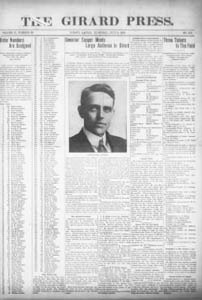
Girard, Kansas Press
The first newspaper published in the county was the Crawford County Times, first published on April 16, 1868. After that one issue, the publication office was returned to the Osage Mission. On November 11, 1869, the Girard Press’s first issue appeared. It became the first newspaper regularly published in the county. On July 14, 1871, the office and contents were burned by a mob due to ill feelings toward the paper because of the troubles over the disposition of the Neutral Lands. Three weeks later, the publication resumed, and the paper appeared better than ever. The newspaper continued operations for 140 years before it was discontinued in 2009.
Other early newspapers included the People’s Vindicator, the Guard Pharos, the Cherokee Pharos, the Cherokee Index, and the Pittsburg Headlight.
In 1868 a Catholic parish was established in Grant township, and a church was built. This was the first church in the county.
A Presbyterian church was built at Girard in 1870, and the Methodist church at Mulberry Grove was established the following year.
Since its organization, Crawford County suffered severely from storms, the worst of which was a tornado that occurred on May 22, 1873. It came from the southwest and swept across the entire county, leaving desolation in its wake. Seven people were killed outright, 34 others were injured, and a large amount of property was destroyed.
Coal of fine quality underlined the entire county and Cherokee County, with some of the veins running five feet or more in thickness. In the beginning, scattered small-scale drift mining and surface mining took place. The first underground shaft mine was built in 1874 near Scammon in Cherokee County. Within no time, more mines were established in both counties. Early mining camps in Crawford County were set up in Washington and Lincoln Townships. The first underground mine was sunk in 1877 in Pittsburg at what is now 2nd and Pine Streets.
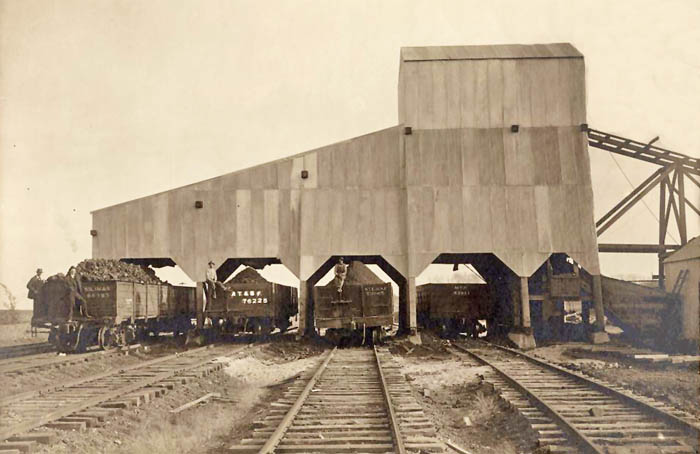
Crawford County, Kansas Coal Mine.
Beginning in about 1880 and lasting for the next 40 years, people from over 50 countries immigrated to Crawford County. Throughout the county, Italian, Dutch, Greek, Spanish, French, Welsh, Lebanese, and at least twenty other languages could be heard in the streets. During these prosperous years, as many as 290 significant mines and numerous other small mines were established in Crawford and Cherokee Counties.
By the early 1880s, the Kansas City, Fort Scott & Gulf Railroad entered the county near the northeast corner, extending south through Arcadia, Coalvale, and Mulberry Grove to Litchfield, where it turned southwest and ran through New Pittsburg to Cherokee, where it turned west and runs through Monmouth and McCune to Parsons, and on to Cherryvale. There is also a branch from Cherokee southeast to Weir. The St. Louis & San Francisco Railroad runs from Girard southeast through New Pittsburg and Opolis to Joplin, Missouri.
In 1885, the Pittsburg & Midway Coal Company was founded in Pittsburg, Kansas. It would continue to operate in Southeast Kansas until large-scale coal mining ceased in the area in the late 20th century. Even after shutting down in Kansas, the company continued to operate elsewhere until September 2007, when it merged with another coal mining company.
In 1886, the Cherokee-Pittsburg Coal Company opened Santa Fe Mine No. 1 in the town of Frontenac. Two years later, on November 9, 1888, Mine No. 2, exploded. Though the mine was considered one of the best, most modern mines in the state, it was dry and had problems with coal dust accumulations. The worst mining disaster in Kansas, the blast was so strong that it broke windows in nearby houses.
“Yesterday evening witnessed the most terrible holocaust that ever occurred in this mining district or the West. Mine No. 2 of the Pittsburg and Cherokee Mining Company at Frontenac blew up, causing a horrible toll of life… At least 200 men, women, and children are gathered around the shaft of the mine… Men are driven to desperation by pitiful appeals by weeping women and girls to get their husbands and fathers and boys out before they all die… Every available doctor from Pittsburg, Girard, Litchfield, and other places from over the district are at the shaft, ready to give emergency treatment… Rescue parties have endeavored to enter the mine but have been driven back by foul air. The air fans were demolished by the explosions and men are working frantically to replace them so air can be sent into the mine.”
— Pittsburg Headlight, November 10, 1888.
The largest operation in the area was the Pittsburg-Weir Coalfield. Located in both Crawford and Cherokee Counties, it was the most extensively mined coal bed in Kansas history, producing over 200 million tons. The coalfield would eventually be home to more than 100 coal camps. This region produced a third of the nation’s bituminous coal and smelted lead and zinc ore in large quantities at one time. Once an underground area of the Weir-Pittsburg seam was mined out, the mines were closed and dismantled, and new mines opened elsewhere in the developing coalfield.
In 1889, construction began on a new brick courthouse. In August 1889, 37 men were working on the building with 18 quarrymen and four teams of horses at a quarry near Farlington. Eleven more men worked at Colonel Daniel’s quarry in Crawford Township to support the project. Designed in the popular Victorian Gothic style, the new building measured 90 feet by 120 feet and was four stories high from the basement to the skylight. The arched doors and windows were framed with elegant cut stone trim, and the roof was slate. The “tower” rooms at all four corners were a defining feature of the Victorian Gothic style. Each one was 23 feet in diameter.
The region’s most active period of coal mining was 1890-1910. More than half the coal mined in the state came from this Crawford County by the 20th century.
The mining communities ranged in size from fewer than 50 people to over 1,000 in places like Arma, Pittsburg, Frontenac, Mulberry, and Radley. However, the majority remained small and had, during their peaks, a maximum of a few hundred inhabitants. The camps were commonly moved, wholesale or in part, after the dissolution of the underground mines around which the camps originally clustered. After being disassembled, the houses, shacks, and other buildings were commonly moved to new camps on railroad flatcars or on huge, flat wagons pulled by mules and horses. Those buildings which were not moved were sold or left to fall into a state of disrepair.
By 1910, the leading crops of the county were corn, oats, hay, wheat, flax, Irish potatoes, and sorghum. Livestock and dairy products were also major sources of revenue. Several railroad lines ran through the county at that time, including the Atchison, Topeka & Santa Fe Railroad; the St. Louis & San Francisco, the Missouri, Kansas & Texas; and the Missouri Pacific systems giving the county nearly 220 miles of track.
In addition to coal, building stone, cement rock, fire, and potter’s clay were of excellent quality and were abundant in several localities. Belts of timber averaging about half a mile in width were found along the streams. Agriculture was also an important industry.
At that time, the population of Crawford County was 51,178, making it the fourth county in the state in population. There were 11 incorporated cities in the county, including Arcadia, Arma, Cherokee, Curranville, Frontenac, Girard, Hepler, McCune, Mulberry, Pittsburg, and Walnut. Other important towns and villages were Beulah, Brazilton, Cato, Chicopee, Croweburg, Dunkirk, Englevale, Farlington, Franklin, Fuller, Midway, Monmouth, and Yale.
By 1911, the elegant courthouse built in 1889 was badly cracked, and the plaster had to be removed and redone. It continued to crack, buckle, and twist in the next years. By 1918, the southwest tower was leaning eight inches out of alignment. In 1920, the offices were moved to various buildings around the square, and the courthouse was razed.
During this time, Crawford County was often referred to as the “Little Balkans” because of the many immigrants from that area of Europe. They came to work in the mines, which did not require much English initially. From the 1880s to the 1920s, over 50 nationalities immigrated to Southeast Kansas because of the coal mines and the associated industries.
Labor unrest and strikes were frequent among the Crawford County miners, where working conditions were often described as terrible. The strikes attracted national attention in the 1890s when hundreds of strikebreakers were brought in from the coal companies to destroy the union’s power. However, the miners gave voice and leadership to the United Mine Workers in establishing the eight-hour workday, safe working conditions, equal pay for equal work, child labor laws, and implementation of minority and women’s rights.
This area was also the site of several illegal bootlegging operations, most of which were organized by immigrants to supplement their meager earnings as strip miners. Kansas had passed Prohibition laws in 1881, long before National Prohibition. Located on the border of Missouri, where alcohol was still legal at the time, provided easy entrance into the world of bootlegging. Law enforcement officers in the area did not take kindly to the business, but when authorities tried to rein in these bootleggers, violence often erupted.
At one point, O.M. Lamb, undersheriff of Crawford County, was struck with an ax by bootlegger John Markovic while performing a raid in Radley, Kansas. The same month, the porch on his house was destroyed by dynamite, breaking windows up to a mile away with the explosion’s impact. Fortunately, Lamb survived both attacks. In later years as national protests against Prohibition strengthened, it became clear that it would not last, and officers ceased their efforts to stop crimes that would likely soon be legal.
In 1914, Crawford County had 63 shaft coal mines, 6,000 workers, and was mining 4.5 million tons of coal. At that time, the area was responsible for one-third of the nation’s coal production. The mining and related industries helped change Crawford County from an agricultural area to an industrial center.
The number of employees in underground mines of the southeast Kansas coal fields reached almost 10,000 during the early years of World War I.
Plans for a new courthouse were made, and the current Crawford County Courthouse was formally dedicated in June 1922. Built on the site of the previous courthouse, it is a three-story structure with a basement measuring 123 feet by 97 feet. Made of Carthage stone, it features marble throughout the interior and over 90 windows.
Underground mining continued as the dominant method until 1931 when mechanized strip mining surpassed output and supplanted it as the dominant mode of mining. This change, combined with competition from eastern coal, led to the demise of the importance of underground mining in the region. Most of the coal camps were dismantled by the 1930s or 1940s.
Another violent storm hit the area on May 4, 2003, when a violent F4 tornado touched down in western Crawford County, several miles west of Frontenac. The towns of Ringo, Franklin, and Mulberry were devastated as the tornado cut a path of destruction roughly one-quarter mile wide.
As of the 2020 census, the county population was 38,972. Its county seat remains in Girard, and its most populous city is Pittsburg.
© Kathy Alexander/Legends of Kansas, updated January 2023.
Also See:
Sources:
Blackmar, Frank W.; Kansas: A Cyclopedia of State History, Vol I; Standard Publishing Company, Chicago, IL 1912.
Bootleggers Beware
Crawford County, Kansas
Cutler, William G; History of Kansas; A. T. Andreas, Chicago, IL, 1883.
Home Authors; A Twentieth Century History and Biographical Record of Crawford County, KS, Lewis Publishing Company, Chicago, IL, 1905
Kansas Memory
Kansas State Historical Society
Wikipedia – Crawford County
Wikipedia – Coal Mining

